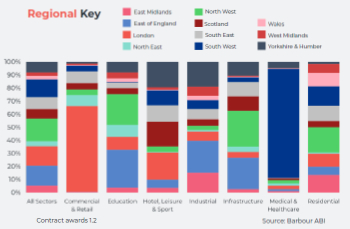Environmental policy for building design and construction
Preparing an environmental policy (or environmental policy statement) is often the first stage in setting and managing environmental objectives for a company or project.
Generally an environmental policy will be part of an environmental management system (EMS) and will sit within a hierarchical suite of documents:
The environmental policy is the over-arching high-level statement of mission and principles in relation to environmental performance and management. It creates the framework for setting environmental objectives and targets and is often a public document.
It is generally a short document (usually one page) and may make general statements about adopting a particular approach to environmental management as well as more specific commitments in relation to areas that might be of particular importance, such as energy use, waste management, the reduction of pollution, compliance with best practice, training and so on (although detailed targets and objectives should appear in the environmental plan, not the environmental policy). It may also commit to adopting a specific Environmental Management System (EMS) such as ISO 14001.
The policy should be signed by a senior director in order to demonstrate commitment and should be dated, and reviewed regularly (usually annually) to take account of changes in organisation, legislation, and so on.
Corporate environmental policies are increasingly common as they are often a requirement of an invitation to tender (along with other policy documents such as equal opportunities, health and safety, corporate social responsibility and so on). Environmental policy templates do exist, but can be so generic as to be meaningless and unless they are supported by a properly thought out environmental management system, they are unlikely to produce beneficial effects.
A specific project, such as a construction project, might adopt a corporate environmental policy, or a project-specific policy might be prepared.
It is important that everyone involved in the project is aware of the environmental policy and environmental plan, and that they are bound by their requirements. Appointment documents should make clear the extent and standard of environmental performance and assessment that is required as well as requirements for monitoring and reporting. These requirements need to be cascaded down throughout the entire supply chain.
This means that a company may have to prepare a project-specific environmental policy to comply with the requirements of an invitation to tender.
Environmental policies should not just be warm words, sat on a shelf or on a distant page of a website. If an environmental policy makes commitments, then the environmental plan should set out how these will be tested and a system put in place to ensure that those tests are undertaken, results are fed back and the policy reviewed to assess whether commitments are being met and whether changes need to be made.
Environmental management systems require policing, and this can be done at a number of different levels:
- A senior client champion should be appointed to take responsibility for environmental matters.
- A client environmental representative should be appointed to manage environmental matters on a day to day basis. On a large project this can be a full-time job for a specialist.
- Contractor’s environmental manager.
- Contractor’s site environmental representative.
- Contractor’s site foreman.
These individuals need to carry out regular inspections, audits and reporting and must be empowered in order to be effective. It is all too easy to ignore environmental requirements, particularly when there are time or budgetary pressures, or when ‘emergencies’ crop up.
[edit] Related articles on Designing Buildings
- Chain of custody.
- Changing lifestyles.
- Climate change science.
- Construction environmental management plan.
- Deleterious materials.
- Ecological impact assessment.
- Eco-Management and Audit Scheme EMAS.
- Energy targets.
- Environmental consultant.
- Environmental impact.
- Environmental impact assessment.
- Environmental legislation.
- Environmental management system.
- Environmental plan.
- Site waste management plan.
- Sustainability.
- Sustainability outcomes.
- Sustainable materials.
- Sustainable Development Goals and the triple bottom line
- Sustainable urban drainage systems.
- Whole life costs.
- Zero carbon homes.
- Zero carbon non-domestic buildings.
[edit] External references
Featured articles and news
Farnborough College Unveils its Half-house for Sustainable Construction Training.
Spring Statement 2025 with reactions from industry
Confirming previously announced funding, and welfare changes amid adjusted growth forecast.
Scottish Government responds to Grenfell report
As fund for unsafe cladding assessments is launched.
CLC and BSR process map for HRB approvals
One of the initial outputs of their weekly BSR meetings.
Architects Academy at an insulation manufacturing facility
Programme of technical engagement for aspiring designers.
Building Safety Levy technical consultation response
Details of the planned levy now due in 2026.
Great British Energy install solar on school and NHS sites
200 schools and 200 NHS sites to get solar systems, as first project of the newly formed government initiative.
600 million for 60,000 more skilled construction workers
Announced by Treasury ahead of the Spring Statement.
The restoration of the novelist’s birthplace in Eastwood.
Life Critical Fire Safety External Wall System LCFS EWS
Breaking down what is meant by this now often used term.
PAC report on the Remediation of Dangerous Cladding
Recommendations on workforce, transparency, support, insurance, funding, fraud and mismanagement.
New towns, expanded settlements and housing delivery
Modular inquiry asks if new towns and expanded settlements are an effective means of delivering housing.
Building Engineering Business Survey Q1 2025
Survey shows growth remains flat as skill shortages and volatile pricing persist.
Construction contract awards remain buoyant
Infrastructure up but residential struggles.
Warm Homes Plan and existing energy bill support policies
Breaking down what existing policies are and what they do.
A dynamic brand built for impact stitched into BSRIA’s building fabric.






















